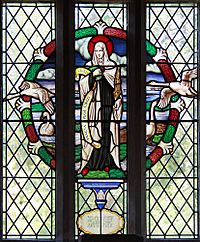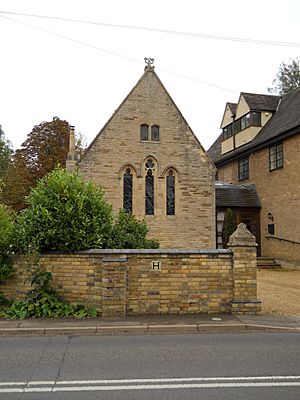Pega facts for kids
Quick facts for kids Saint Pega |
|
|---|---|

Stained glass window depicting Saint Pega in Peakirk church
|
|
| Anchoress | |
| Born | c. 673 Mercia |
| Died | c. 719 Rome |
| Venerated in | Catholic Church Anglican Churches Eastern Orthodox Church |
| Major shrine | Peakirk (partially destroyed) |
| Feast | 8 January |
Saint Pega (born around 673, died around 719) was an important Christian saint. She lived as an anchoress (a religious person who lives alone, away from others, for prayer). Pega lived in the ancient Anglo-Saxon kingdom of Mercia. She was also the sister of another famous saint, Saint Guthlac.
Contents
The Life of Saint Pega
Pega was born into a powerful noble family in Mercia. Her father was Penwalh. She chose to live a quiet, religious life as an anchoress. Her home was in a place now called Peakirk, which means "Pega's church." This was close to her brother Guthlac's hermitage (a place where a hermit lives) in Crowland.
Pega and Saint Guthlac
Pega and Guthlac were very close. When Guthlac knew he was going to die in 714, he asked Pega to come to him. She traveled by boat to his home to bury him. About a year later, she was there when his body was moved to a new tomb. People were amazed to find that his body had not decayed. This was seen as a miracle.
Pega also performed a miracle herself. She used a special piece of salt that Guthlac had blessed. With it, she helped a blind man from Wisbech to see again.
There's also a story that says Pega was once mistaken for the devil. The devil took on her appearance to try and trick Guthlac into breaking his fast. Because of this, Guthlac sent "Pega" away from Crowland.
Later stories say that Pega inherited some of Guthlac's personal items. These included his psalter (a book of psalms) and his scourge (a whip used for religious discipline). She later gave these items to Kenulph, who was the first abbot of Crowland Abbey.
Death, Miracles, and Legacy
After her brother Guthlac died, Pega went on a long journey. She traveled to Rome, a very important city for Christians. She died there on January 8, 719.
People believed that miracles happened at a church built in Rome in her honor. This shows how much she was respected and remembered.
Pega's Church in Peakirk
The exact spot where Pega lived as an anchoress is not known for sure. However, it is thought to be where a chapel was built in the 13th century. This place is now called St Pega's Hermitage in Peakirk. Today, it is a private home.
The local Church of England parish church in Peakirk is special because it is the only one dedicated to Saint Pega. There is a local story that Pega's heart was brought back to Peakirk. It was kept as a holy relic in the church, inside a "heart stone." You can still see parts of this broken stone in a window of the church.
St Pega's Hermitage
St Pega's Hermitage is a historic building in Peakirk. It was once a chapel and is believed to be where Saint Pega lived. The oldest part of the building, the chancel, was built around 1300. A nave (the main part of a church) was added in the 15th century.
Over the centuries, the building was rebuilt and restored many times. In the 1850s, it became a home for Anglican nuns. They added more living spaces in 1937. Different groups of nuns lived there until 2001. After the nuns left, the building was sold and became a private home. The chapel part of the house still has its original altar and other old features. The Hermitage is considered a Grade II listed building, which means it is historically important.



